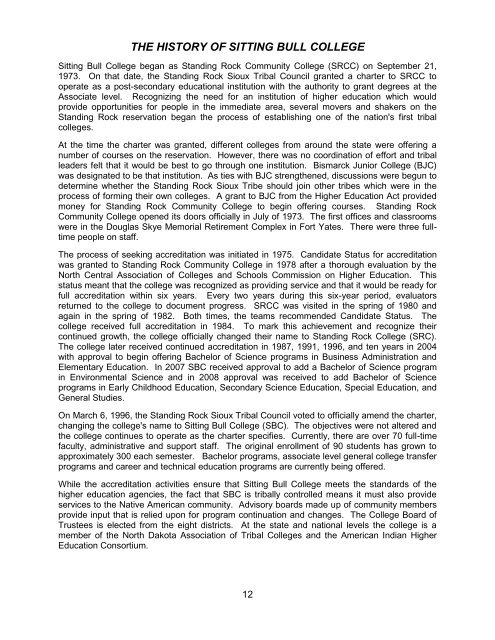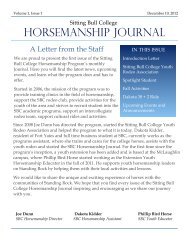division of education - Sitting Bull College
division of education - Sitting Bull College
division of education - Sitting Bull College
Create successful ePaper yourself
Turn your PDF publications into a flip-book with our unique Google optimized e-Paper software.
THE HISTORY OF SITTING BULL COLLEGE<br />
<strong>Sitting</strong> <strong>Bull</strong> <strong>College</strong> began as Standing Rock Community <strong>College</strong> (SRCC) on September 21,<br />
1973. On that date, the Standing Rock Sioux Tribal Council granted a charter to SRCC to<br />
operate as a post-secondary <strong>education</strong>al institution with the authority to grant degrees at the<br />
Associate level. Recognizing the need for an institution <strong>of</strong> higher <strong>education</strong> which would<br />
provide opportunities for people in the immediate area, several movers and shakers on the<br />
Standing Rock reservation began the process <strong>of</strong> establishing one <strong>of</strong> the nation's first tribal<br />
colleges.<br />
At the time the charter was granted, different colleges from around the state were <strong>of</strong>fering a<br />
number <strong>of</strong> courses on the reservation. However, there was no coordination <strong>of</strong> effort and tribal<br />
leaders felt that it would be best to go through one institution. Bismarck Junior <strong>College</strong> (BJC)<br />
was designated to be that institution. As ties with BJC strengthened, discussions were begun to<br />
determine whether the Standing Rock Sioux Tribe should join other tribes which were in the<br />
process <strong>of</strong> forming their own colleges. A grant to BJC from the Higher Education Act provided<br />
money for Standing Rock Community <strong>College</strong> to begin <strong>of</strong>fering courses. Standing Rock<br />
Community <strong>College</strong> opened its doors <strong>of</strong>ficially in July <strong>of</strong> 1973. The first <strong>of</strong>fices and classrooms<br />
were in the Douglas Skye Memorial Retirement Complex in Fort Yates. There were three fulltime<br />
people on staff.<br />
The process <strong>of</strong> seeking accreditation was initiated in 1975. Candidate Status for accreditation<br />
was granted to Standing Rock Community <strong>College</strong> in 1978 after a thorough evaluation by the<br />
North Central Association <strong>of</strong> <strong>College</strong>s and Schools Commission on Higher Education. This<br />
status meant that the college was recognized as providing service and that it would be ready for<br />
full accreditation within six years. Every two years during this six-year period, evaluators<br />
returned to the college to document progress. SRCC was visited in the spring <strong>of</strong> 1980 and<br />
again in the spring <strong>of</strong> 1982. Both times, the teams recommended Candidate Status. The<br />
college received full accreditation in 1984. To mark this achievement and recognize their<br />
continued growth, the college <strong>of</strong>ficially changed their name to Standing Rock <strong>College</strong> (SRC).<br />
The college later received continued accreditation in 1987, 1991, 1996, and ten years in 2004<br />
with approval to begin <strong>of</strong>fering Bachelor <strong>of</strong> Science programs in Business Administration and<br />
Elementary Education. In 2007 SBC received approval to add a Bachelor <strong>of</strong> Science program<br />
in Environmental Science and in 2008 approval was received to add Bachelor <strong>of</strong> Science<br />
programs in Early Childhood Education, Secondary Science Education, Special Education, and<br />
General Studies.<br />
On March 6, 1996, the Standing Rock Sioux Tribal Council voted to <strong>of</strong>ficially amend the charter,<br />
changing the college's name to <strong>Sitting</strong> <strong>Bull</strong> <strong>College</strong> (SBC). The objectives were not altered and<br />
the college continues to operate as the charter specifies. Currently, there are over 70 full-time<br />
faculty, administrative and support staff. The original enrollment <strong>of</strong> 90 students has grown to<br />
approximately 300 each semester. Bachelor programs, associate level general college transfer<br />
programs and career and technical <strong>education</strong> programs are currently being <strong>of</strong>fered.<br />
While the accreditation activities ensure that <strong>Sitting</strong> <strong>Bull</strong> <strong>College</strong> meets the standards <strong>of</strong> the<br />
higher <strong>education</strong> agencies, the fact that SBC is tribally controlled means it must also provide<br />
services to the Native American community. Advisory boards made up <strong>of</strong> community members<br />
provide input that is relied upon for program continuation and changes. The <strong>College</strong> Board <strong>of</strong><br />
Trustees is elected from the eight districts. At the state and national levels the college is a<br />
member <strong>of</strong> the North Dakota Association <strong>of</strong> Tribal <strong>College</strong>s and the American Indian Higher<br />
Education Consortium.<br />
12








